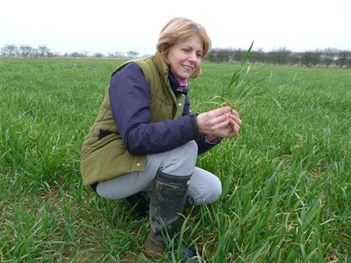More growers than usual will be growing spring crops this season, either by choice or as a result of circumstances forced on them by our climate.
 With many new to spring cropping, Christine Lilly, an advisor with Frontier, gives advice on the specific agronomic considerations for some of the key spring crops:
With many new to spring cropping, Christine Lilly, an advisor with Frontier, gives advice on the specific agronomic considerations for some of the key spring crops:
Spring barley
Drilling into a seed bed that is warming up will encourage rapid germination. Pest damage can cause problems in early drilled crops. If grassweeds are likely to be present then pre-emergence herbicide is vital. Apply chlorotoluron + diflufenican (this requires the grower to have a copy of the relevant EAMU on farm). Broad leaved weeds can be dealt with at the late tillering stage with either a sulphonylurea (metsulfuron-methyl + tribenuron or thifensulfuron-methyl) + hbn or mecoprop. If poppies have been difficult to control in the past, and resistance is suspected, consider adding MCPA.
Disease control usually revolves around a two spray programme. In some seasons, and especially in the north, an early T0 has proved valuable. SDHI chemistry such as bixafen, fluxapyroxad or penthiopyrad (subject to approval) will all give good disease control when used in partner with triazole and/or strobilurin. Remember, products containing fluxapyroxad must NOT be used on malting barley as there is no IOB approval as yet.
Ramularia can often be a problem later in the season in spring barley. The addition of chlorothalonil at the T2 timing has proved beneficial. Do check the label to ensure the brand you use has approval for use on spring barley.
Given this likely increase in spring barley, targeting yield on heavy land is likely to be the best approach, as malting premium will be under pressure. That way, if low grain nitrogens are achieved then any premium can still be applied, but yield hasn't been compromised.
Spring peas
These are very sensitive to compaction. Although direct drilling and min-till are becoming more popular, soil conditions must be right if this approach is to be used to establish peas. Otherwise, land should be ploughed. Seed must be covered by at least 3cm of soil. This is particularly important as pre-emergence herbicides are an important component of achieving good weed control and successful establishment. An imazamox/pendimethalin + clomazone/linuron mixture will cover a wide range of the key broad leaved weeds.
Wet summers encourage foliar diseases such as leaf and pod spot and botrytis. Apply the first fungicide at the earliest sign of disease and follow up 21 days later. Boscalid + pyraclostrobin or chlorothalonil + pyrimethanil will give broad spectrum cover.
Weevils, pea aphid and pea moth are all pests that can commonly be found. Thresholds are available for each pest and appropriate insecticides should be applied.
The most common disorder caused by lack of micronutrients is marsh spot (manganese deficiency). The deficiency causes brown spots to form in the centre of the peas and is most common on organic/alkaline soils. If this is not managed it will reduce the quality of the peas and result in them only being suitable for feed.
Spring beans
Successful spring bean establishment is very weather dependent. Weed control can be affected by soil moisture (or lack of) at the time of application of pre-emergence applications. Where weeds are present, glyphosate applied prior to drilling will aid control of grassweeds and perennial weeds.
Options for weed control in spring field beans are limited both pre and post emergence. Pre-emergence residual herbicides work best if applied to soils with adequate soil moisture. Unless conditions at application are ideal (moist fine seed beds), it is unlikely that pre-emergence products will give full control of weeds.
Residual products are ineffective on highly organic soils, and some are damaging on gravelly or very light soil types. Ensure seed is well covered with soil in order to avoid crop damage from herbicides and avoid applying just prior to heavy rain or to very cloddy seed beds. Apply as soon as possible after drilling to avoid the bean plumule getting too close to the soil surface at application. An imazamox/pendimethalin + clomazone/linuron mixture will cover a wide range of broad leaved weeds. Bentazone is the only post-emergence active for use in spring beans for broad leaved weed control.
Downy mildew can be a problem in spring beans and the co-formulated product of metalaxyl + chlorothalonil has been revoked for use on spring beans with a sell out date of 31 May 2013, prior to a use up date of 31 May 2014. Current spring bean varieties do not have high levels of downy mildew resistance. Where there is a history of downy mildew on the farm and beans are being grown fewer than five years since the last bean crop, it is advisable to use a seed dressing. Work is underway on a submission for an extension on the use of metalaxyl on field beans - with advice to tank-mix with another effective downy mildew fungicide. However, this is unlikely to be available until early May, 2013.
Always take professional advice when making crop production decisions. To arrange to speak to a Frontier agronomist email This email address is being protected from spambots. You need JavaScript enabled to view it.









